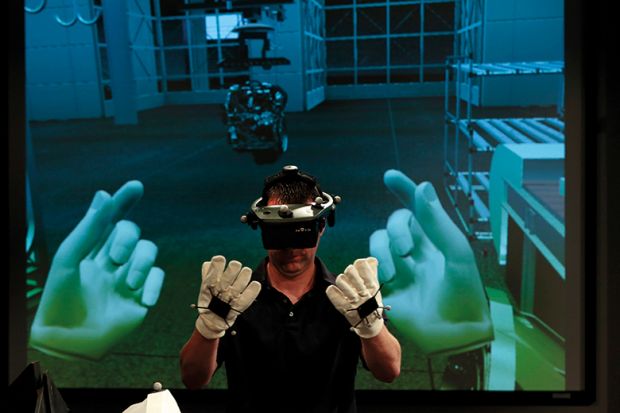Google and a Danish technology firm claim that they have removed the need for biology students to set foot in a laboratory by creating virtual reality simulations of experiments, clearing the way for the world’s first online-only biology degree.
The partnership is a sign that VR is beginning to change how the physical sciences are taught, although there is scepticism over whether the technology can entirely replace hands-on lab experience.
Announcing the initiative at Google’s I/O developers conference, Jennifer Holland, a programme manager at the company, said that using VR labs, universities “will now be able to truly offer an online biology degree”.
Although online biology courses are common, many require in-person lab work, she said, which means higher fees or long commuting distances for remote students. “It turns out this doesn’t scale,” she added. VR labs also give students unlimited lab time, an impossible offer in physical laboratories.
Among the 30 labs planned are ones allowing training in confocal microscopy, gene therapy and cytogenetics. According to Google’s announcement, Arizona State University will be the first institution to use the labs in VR this autumn, launching an online-only biological sciences degree.
An Arizona State spokeswoman said that academics had worked with Labster, the Danish technology firm, to ensure that the online-only degree met the same standards as campus-based courses.
“The goal of this course, along with additional courses that will be added in the future, is to provide students with the knowledge and skill set they need, through the use of virtual simulations, for them to apply this learning in the real world,” she said. “These labs also provide access to students who historically couldn’t take these courses due to geographic constraints, while also enabling students to have unlimited lab time, which is something that’s not possible today.”
Richard Campen, an associate lecturer in biology at the Open University who has written about online learning, said that a “full substitution of the real world for virtual is…likely to be a poor-quality experience that may not stand students in good stead when they start work in the real world”.
But the OU does use virtual microscopes and webcasts of experiments, for example, as part of its biology courses, he explained.
“For me, the really important thing is that…they have to be as realistic as you can make them,” he said. “It’s about demonstrating scientific method.”
The VR labs will simulate “real-world outcomes” using “advanced simulations and mathematical equations”, according to Google’s presentation. That the experiments were carried out in a model of reality, rather than reality itself, was not necessarily a problem, Dr Campen said. “People learn to fly aeroplanes in models – they’re called simulators,” he said. “I don’t think there’s anything wrong with this…it has its place.”
But students performing an experiment in a virtual lab would not necessarily confront all the possible variables and confounding factors that they might encounter in a physical lab, he added.
If a student had only ever used a virtual lab, “are you going to employ that student?” Dr Campen asked.
A spokesman for Labster argued that the technology would offer significant benefits to online-only and campus degrees.
“Many of the labs are built with the use of mathematical modelling that simulates what would happen in the real world. There’s also the ability to dive in and see the reactions and processes at the molecular level, using complex animations that are based on modelling databases,” he said.
“Combining that with the actual immersive environment and interactivity, while allowing students to drive the whole experience…makes students more confident stepping into a lab and using the equipment, but also gives them a better understanding of the concepts and how to apply them.”
Students will also require access to their own VR headsets. The labs run on headsets including Google’s Daydream View, which costs $99 (£74), although this also requires a recent smartphone to act as the screen.
Register to continue
Why register?
- Registration is free and only takes a moment
- Once registered, you can read 3 articles a month
- Sign up for our newsletter
Subscribe
Or subscribe for unlimited access to:
- Unlimited access to news, views, insights & reviews
- Digital editions
- Digital access to THE’s university and college rankings analysis
Already registered or a current subscriber? Login










